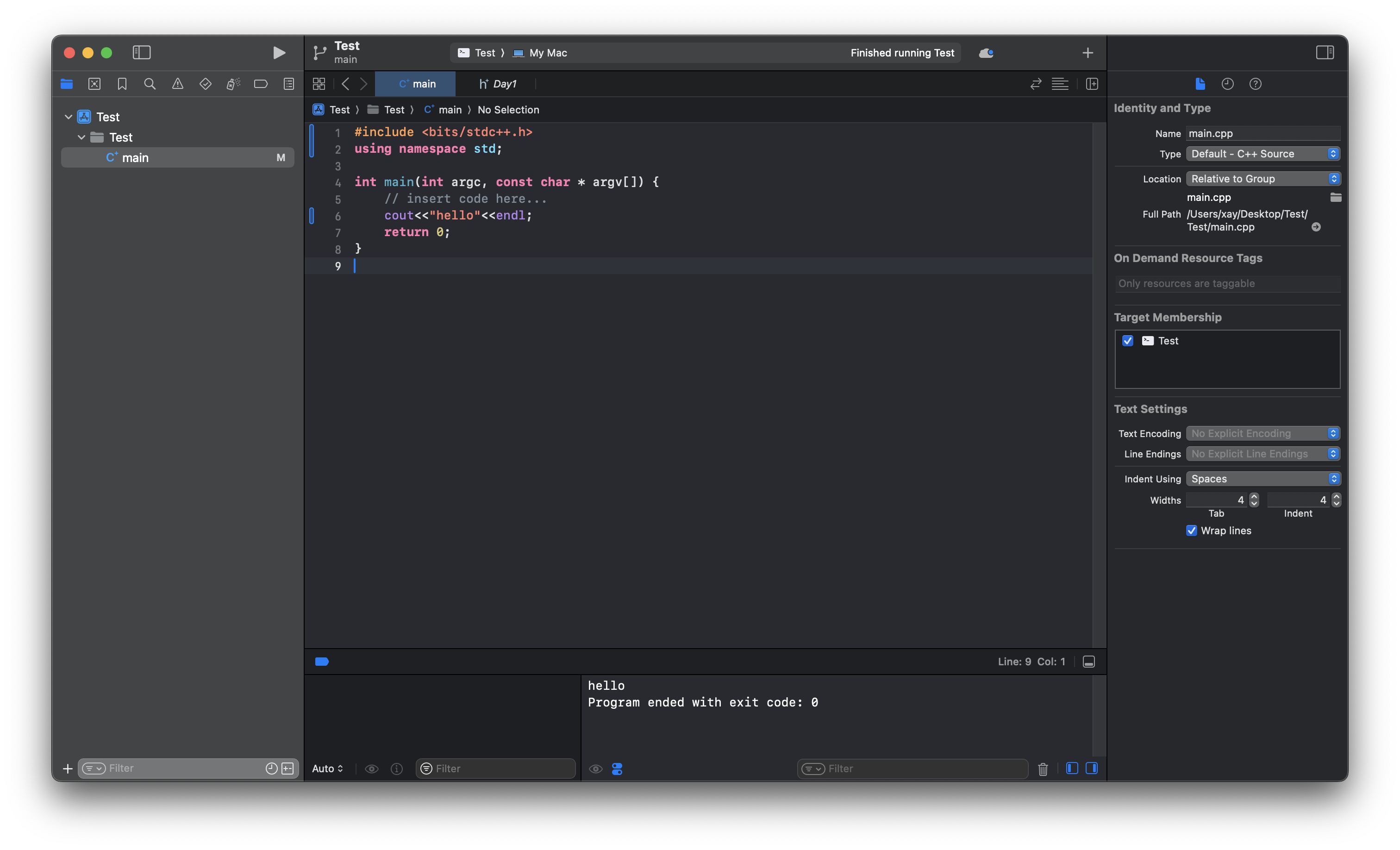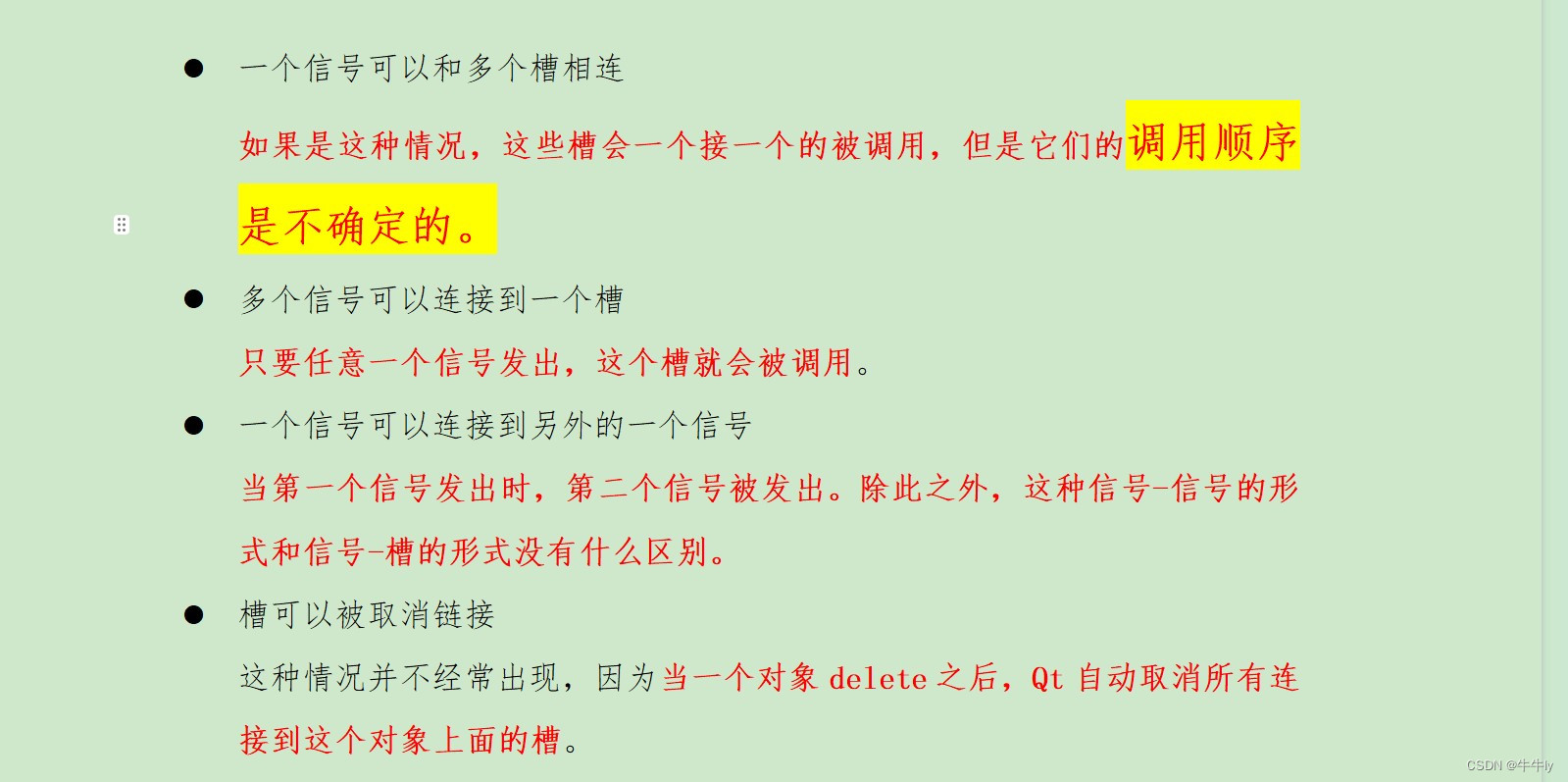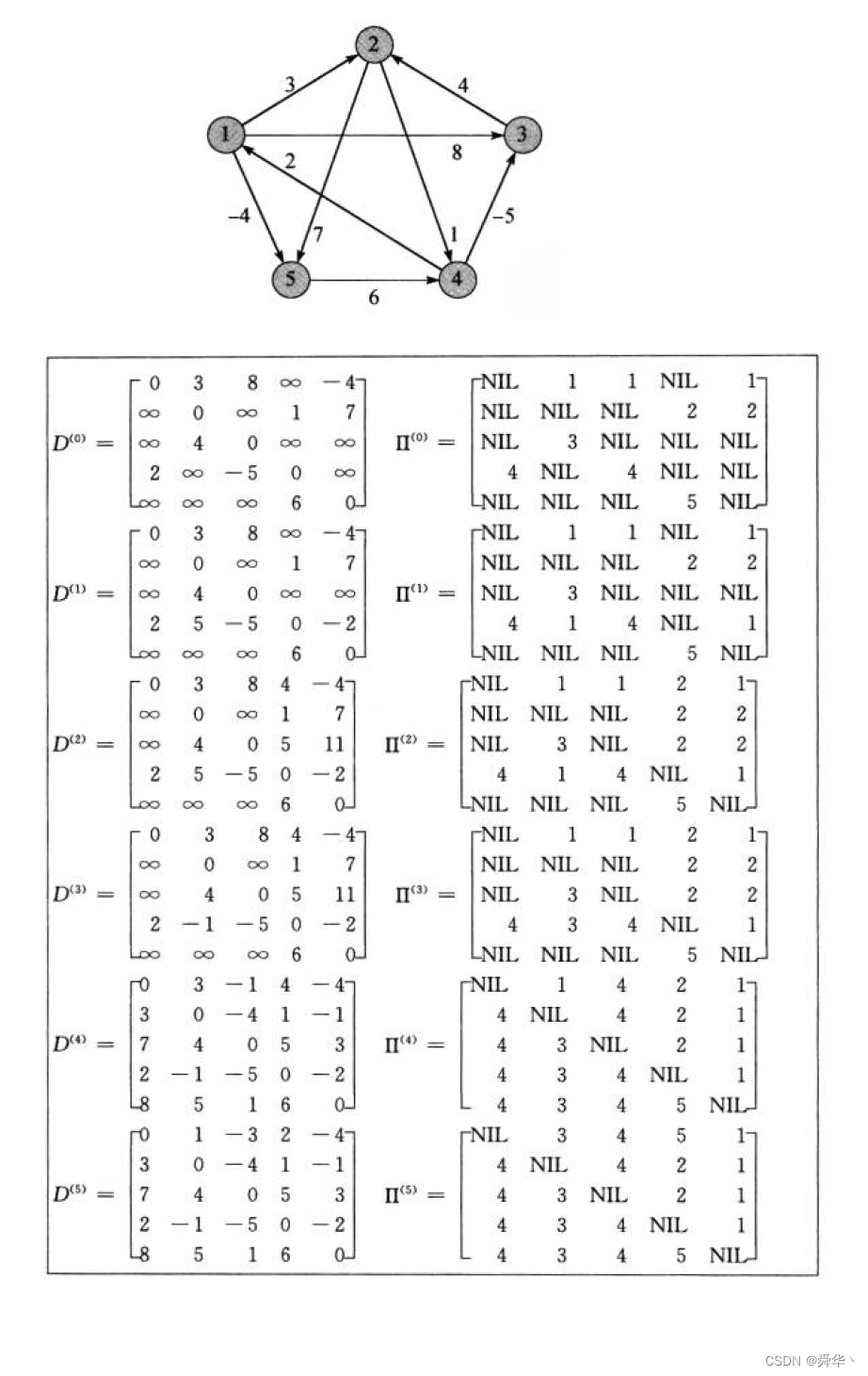一、张量的操作:拼接、切分、索引和变换
(1)张量拼接与切分
1.1 torch.cat()
功能:将张量按维度dim进行拼接
• tensors: 张量序列
• dim : 要拼接的维度
torch.cat(tensors, dim=0, out=None)函数用于沿着指定维度dim将多个张量拼接在一起。它接受一个张量列表tensors作为输入,并返回一个拼接后的张量。参数dim指定了拼接的维度,默认为0。
flag = True
if flag:t = torch.ones((2, 3)) #创建一个形状为(2, 3)的全为1的张量tt_0 = torch.cat([t, t], dim=0) # 将张量t沿着dim=0的维度拼接两次,得到张量t_0t_1 = torch.cat([t, t, t], dim=1)# 将张量t沿着dim=1的维度拼接三次,得到张量t_1print("t_0:{} shape:{}\nt_1:{} shape:{}".format(t_0, t_0.shape, t_1, t_1.shape))
t_0:tensor([[1., 1., 1.],[1., 1., 1.],[1., 1., 1.],[1., 1., 1.]]) shape:torch.Size([4, 3])
t_1:tensor([[1., 1., 1., 1., 1., 1., 1., 1., 1.],[1., 1., 1., 1., 1., 1., 1., 1., 1.]]) shape:torch.Size([2, 9])
- format()用于将t_0、t_0.shape、t_1和t_1.shape的值插入到字符串中的占位符位置。具体来说,{}是占位符,format()方法将会将对应的值填充到这些占位符的位置。
- 例如,“t_0:{} shape:{}\nt_1:{} shape:{}”.format(t_0, t_0.shape, t_1, t_1.shape)中的{}将会分别被t_0、t_0.shape、t_1和t_1.shape的值所替代。
1.2 torch.stack()
功能:在新创建的维度dim上进行拼接
• tensors:张量序列
• dim :要拼接的维度
torch.stack(tensors, dim=0, out=None)函数用于沿着指定维度dim将多个张量堆叠在一起。它接受一个张量列表tensors作为输入,并返回一个堆叠后的张量。参数dim指定了堆叠的维度,默认为0。
以下是示例代码:
import torch
# 示例张量
tensor1 = torch.tensor([1, 2, 3])
tensor2 = torch.tensor([4, 5, 6])
tensor3 = torch.tensor([7, 8, 9])
# 使用torch.cat()函数拼接张量
cat_result = torch.cat([tensor1, tensor2, tensor3], dim=0)
print("torch.cat()拼接结果:", cat_result)# 使用torch.stack()函数堆叠张量
stack_result = torch.stack([tensor1, tensor2, tensor3], dim=0)
print("torch.stack()堆叠结果:", stack_result)
输出结果为:
torch.cat()拼接结果: tensor([1, 2, 3, 4, 5, 6, 7, 8, 9])
torch.stack()堆叠结果: tensor([[1, 2, 3],[4, 5, 6],[7, 8, 9]])
1.3 torch.chunk()
torch.chunk()是PyTorch中的一个函数,用于将张量沿着指定维度进行分块。
函数的参数包括:
input:要分块的输入张量。chunks:要分成的块数。dim(可选):指定要分块的维度,默认为0。
函数返回一个元组,包含分块后的张量块。
以下是一个示例代码:
import torch
x = torch.tensor([[1, 2, 3],[4, 5, 6],[7, 8, 9]])
chunks = torch.chunk(x, chunks=3, dim=0)
for chunk in chunks:print(chunk)
在上述代码中,我们创建了一个形状为(3, 3)的张量x。然后,我们使用torch.chunk()函数将x沿着dim=0的维度分成3块。
最后,我们使用for循环遍历每个分块,并打印出来。运行代码后,输出如下:
tensor([[1, 2, 3]])
tensor([[4, 5, 6]])
tensor([[7, 8, 9]])
可以看到,x被分成了3个块,每个块是一个形状为(1, 3)的张量。
1.4 torch.split()
torch.split()是PyTorch中的一个函数,用于将张量沿着指定维度进行切分。
函数的参数包括:
tensor:要切分的输入张量。split_size_or_sections:切分的大小或切分的份数。当split_size_or_sections为整数时,表示每一份的长度;当split_size_or_sections为列表时,按照列表元素进行切分。dim(可选):指定要切分的维度,默认为0。
函数返回一个张量列表,包含切分后的张量。
以下是一个示例代码:
import torch
x = torch.tensor([[1, 2, 3, 4, 5],[6, 7, 8, 9, 10],[11, 12, 13, 14, 15]])
splits = torch.split(x, split_size_or_sections=2, dim=1)
for split in splits:print(split)
在上述代码中,我们创建了一个形状为(3, 5)的张量x。然后,我们使用torch.split()函数将x沿着dim=1的维度切分为大小为2的块。
最后,我们使用for循环遍历每个切分块,并打印出来。运行代码后,输出如下:
tensor([[ 1, 2],[ 6, 7],[11, 12]])
tensor([[ 3, 4],[ 8, 9],[13, 14]])
tensor([[ 5],[10],[15]])
可以看到,x被切分成了3个块,每个块的大小为(3, 2)、(3, 2)和(3, 1)。
(2)张量索引
2.1 torch.index_select()
torch.index_select()是PyTorch中的一个函数,用于按索引从输入张量中选择元素。
函数的参数包括:
input:输入张量。dim:指定按哪个维度进行选择。index:选择元素的索引。可以是一个张量或一个整数列表。out(可选):输出张量,用于存储结果。
函数返回一个新的张量,包含按索引选择的元素。
以下是一个示例代码:
import torch# 创建一个输入张量
import torch# 创建一个输入张量
x = torch.tensor([[1, 2, 3],[4, 5, 6],[7, 8, 9]])# 创建一个索引张量
indices = torch.tensor([0, 2])# 使用 torch.index_select() 函数按索引从输入张量中选择元素
selected = torch.index_select(x, dim=0, index=indices)# 打印选择的结果
print(selected)在上述代码中,我们创建了一个形状为(3, 3)的张量x。然后,我们使用torch.index_select()函数从x中按dim=0的维度选择索引为[0, 2]的元素。
最后,我们打印出选择的结果。运行代码后,输出如下:
tensor([[1, 2, 3],[7, 8, 9]])
可以看到,选择的结果是一个形状为(2, 3)的张量,其中包含了x中索引为0和2的两行。
2.2 torch.masked_select()
功能:按mask中的True进行索引
返回值:一维张量
• input: 要索引的张量
• mask: 与input同形状的布尔类型张量
import torch
# 创建一个输入张量
input = torch.tensor([[1, 2, 3],[4, 5, 6],[7, 8, 9]])
# 创建一个掩码张量
mask = torch.tensor([[1, 0, 1],[0, 1, 0],[1, 0, 1]], dtype=torch.bool)
# 使用 torch.masked_select() 函数根据掩码从输入张量中选择元素
output = torch.masked_select(input, mask)
print(output)
这段代码使用了 torch.masked_select() 函数,它的作用是根据掩码 mask 从输入张量 input 中选择元素。
在代码中,我们首先创建了一个形状为 (3, 3) 的输入张量 input。然后,我们创建了一个与输入张量形状相同的掩码张量 mask,其中的元素为布尔类型,用来指示要选择的元素。
接下来,我们调用 torch.masked_select() 函数,传入输入张量 input 和掩码张量 mask。函数会根据掩码选择对应位置为 True 的元素,并返回一个新的张量。
最后,我们将选择的结果存储在输出张量 output 中,并打印出来。运行代码后,输出如下:
tensor([1, 3, 5, 7, 9])
可以看到,输出张量 output 包含了输入张量 input 中掩码为 True 的元素。
(3)张量变换
3.1 torch.reshape()
功能:变换张量形状
注意事项:当张量在内存中是连续时,新张量与input共享数据内存
• input: 要变换的张量
• shape: 新张量的形状
import torch
# 创建一个输入张量
input = torch.tensor([[1, 2, 3],[4, 5, 6]])
# 使用 torch.reshape() 函数改变张量的形状
output = torch.reshape(input, (3, 2))
print(output)
这段代码使用了 torch.reshape() 函数,它的作用是改变张量的形状。
在代码中,我们首先创建了一个形状为 (2, 3) 的输入张量 input。然后,我们调用 torch.reshape() 函数,传入输入张量 input 和目标形状 (3, 2)。
函数会将输入张量 input 改变为目标形状 (3, 2),并返回一个新的张量。
最后,我们将改变形状后的结果存储在输出张量 output 中,并打印出来。运行代码后,输出如下:
tensor([[1, 2],[3, 4],[5, 6]])
可以看到,输出张量 output 的形状已经被改变为 (3, 2),其中的元素顺序与输入张量 input 保持一致。
3.2 torch.transpose()
功能:交换张量的两个维度
• input: 要变换的张量
• dim0: 要交换的维度
• dim1: 要交换的维度
import torch
# 创建一个输入张量
input = torch.tensor([[1, 2, 3],[4, 5, 6]])
# 使用 torch.transpose() 函数交换张量的维度
output = torch.transpose(input, 0, 1)
print(output)
这段代码使用了 torch.transpose() 函数,它的作用是交换张量的维度。
在代码中,我们首先创建了一个形状为 (2, 3) 的输入张量 input。然后,我们调用 torch.transpose() 函数,传入输入张量 input 和要交换的维度 dim0=0 和 dim1=1。
函数会将输入张量 input 的维度 0 和维度 1 进行交换,并返回一个新的张量。
最后,我们将交换维度后的结果存储在输出张量 output 中,并打印出来。运行代码后,输出如下:
tensor([[1, 4],[2, 5],[3, 6]])
可以看到,输出张量 output 的维度已经被交换,形状变为 (3, 2),其中的元素顺序与输入张量 input 保持一致。
3.3 torch.t()
功能:2维张量转置,对矩阵而言,等价于 torch.transpose(input, 0, 1)
import torch
# 创建一个输入张量
input = torch.tensor([[1, 2, 3],[4, 5, 6]])
# 使用 torch.t() 函数转置张量
output = torch.t(input)
print(output)
这段代码使用了 torch.t() 函数,它的作用是对张量进行转置操作。
在代码中,我们首先创建了一个形状为 (2, 3) 的输入张量 input。然后,我们调用 torch.t() 函数,传入输入张量 input。
函数会将输入张量 input 进行转置,并返回一个新的张量。
最后,我们将转置后的结果存储在输出张量 output 中,并打印出来。运行代码后,输出如下:
tensor([[1, 4],[2, 5],[3, 6]])
可以看到,输出张量 output 的维度已经被转置,形状变为 (3, 2),其中的元素顺序与输入张量 input 保持一致
3.4 torch.squeeze()
功能:压缩长度为1的维度(轴)
• dim: 若为None,移除所有长度为1的轴;若指定维度,当且仅当该轴长度为1时,可以被移除;
import torch
# 创建一个输入张量
input = torch.tensor([[[1, 2, 3],[4, 5, 6]]])
# 使用 torch.squeeze() 函数去除张量的尺寸为 1 的维度
output = torch.squeeze(input)
print(output)
这段代码使用了 torch.squeeze() 函数,它的作用是去除张量中尺寸为 1 的维度。
在代码中,我们首先创建了一个形状为 (1, 2, 3) 的输入张量 input。然后,我们调用 torch.squeeze() 函数,传入输入张量 input。
函数会去除输入张量 input 中尺寸为 1 的维度,并返回一个新的张量。
最后,我们将去除尺寸为 1 的维度后的结果存储在输出张量 output 中,并打印出来。运行代码后,输出如下:
tensor([[1, 2, 3],[4, 5, 6]])
可以看到,输出张量 output 的形状已经被修改,尺寸为 1 的维度被去除,变为 (2, 3)。
3.5 torchunsqueeze()
功能:依据dim扩展维度
• dim: 扩展的维度
抱歉,我之前给出的回答有误。在PyTorch中没有 torch.usqueeze() 函数。正确的函数是 torch.unsqueeze(),它的作用是在指定的维度上增加一个大小为1的维度。
以下是使用 torch.unsqueeze() 函数的示例代码:
import torch
# 创建一个输入张量
input = torch.tensor([[1, 2, 3],[4, 5, 6]])
# 使用 torch.unsqueeze() 函数在维度0上增加一个大小为1的维度
output = torch.unsqueeze(input, dim=0)
print(output)
在这个示例中,我们创建了一个形状为 (2, 3) 的输入张量 input。然后,我们调用 torch.unsqueeze() 函数,传入输入张量 input 和要增加维度的维度索引 dim=0。
函数会在维度0上增加一个大小为1的维度,并返回一个新的张量。
最后,我们将增加维度后的结果存储在输出张量 output 中,并打印出来。运行代码后,输出如下:
tensor([[[1, 2, 3],[4, 5, 6]]])
可以看到,输出张量 output 的形状已经被修改,维度0上增加了一个大小为1的维度。
二、张量数学运算
一、加减乘除
torch.add(input, other, alpha=1):将输入张量input和另一个张量other按元素相加,并返回结果张量。可选参数alpha控制相加的缩放因子。
torch.add() 功能:逐元素计算 input+alpha×other
• input: 第一个张量
• alpha: 乘项因子
• other: 第二个张量
torch.add(input, alpha=1, other, out=None) 是一个用于执行张量相加操作的函数。
参数说明:
input:输入张量。alpha:一个可选的缩放因子,默认为1。它用于将other张量与input张量相乘后再相加。other:另一个张量,与input张量进行相加操作。out:可选的输出张量,用于存储结果。
函数功能:
该函数将输入张量input与另一个张量other进行按元素相加的操作,并返回结果张量。如果提供了out参数,结果将存储在out张量中;否则,将创建一个新的张量来存储结果。
请注意,input和other的形状必须是可广播的,否则会引发错误。广播机制允许在不同形状的张量之间执行按元素操作。
示例用法:
import torch
input = torch.tensor([1, 2, 3])
other = torch.tensor([4, 5, 6])
result = torch.add(input, alpha=2, other=other)
print(result) # 输出: tensor([9, 12, 15])
在这个示例中,input 张量为 [1, 2, 3],other 张量为 [4, 5, 6],alpha 参数为2。函数将 input 与 other 相乘得到 [2, 4, 6],然后再与 other 相加得到结果 [6, 9, 12]。
torch.addcdiv(input, tensor1, tensor2, value=1):将输入张量input与张量tensor1的按元素除法结果与张量tensor2相乘,然后加上一个标量值value,并返回结果张量。

torch.addcmul(input, tensor1, tensor2, value=1):将输入张量input与张量tensor1的按元素乘法结果与张量tensor2相加,然后加上一个标量值value,并返回结果张量。

torch.addcmul(input, value=1, tensor1, tensor2, out=None) 是一个执行逐元素乘法和加法操作的函数。
参数说明:
input:输入张量。value:一个可选的缩放因子,默认为1。它用于将tensor1与tensor2相乘后再与input相加。tensor1:第一个张量,与tensor2相乘。tensor2:第二个张量,与tensor1相乘。out:可选的输出张量,用于存储结果。
函数功能:
该函数将输入张量input与tensor1和tensor2进行逐元素相乘,并将结果与input相加。如果提供了out参数,结果将存储在out张量中;否则,将创建一个新的张量来存储结果。
请注意,input、tensor1和tensor2的形状必须是可广播的,否则会引发错误。广播机制允许在不同形状的张量之间执行按元素操作。
示例用法:
import torch
input = torch.tensor([1, 2, 3])
tensor1 = torch.tensor([4, 5, 6])
tensor2 = torch.tensor([2, 3, 4])
result = torch.addcmul(input, value=0.5, tensor1=tensor1, tensor2=tensor2)
print(result) # 输出: tensor([5., 7.5, 10.])
在这个示例中,input 张量为 [1, 2, 3],tensor1 张量为 [4, 5, 6],tensor2 张量为 [2, 3, 4],value 参数为0.5。函数将 tensor1 与 tensor2 逐元素相乘得到 [8, 15, 24],然后再与 input 相加得到结果 [9, 17, 27]。
torch.sub(input, other):将输入张量input和另一个张量other按元素相减,并返回结果张量。torch.div(input, other):将输入张量input和另一个张量other按元素相除,并返回结果张量。torch.mul(input, other):将输入张量input和另一个张量other按元素相乘,并返回结果张量。
二、对数,指数,幂函数
torch.log(input, out=None):计算输入张量input的自然对数,并返回结果张量。torch.log10(input, out=None):计算输入张量input的以10为底的对数,并返回结果张量。torch.log2(input, out=None):计算输入张量input的以2为底的对数,并返回结果张量。torch.exp(input, out=None):计算输入张量input的指数函数,即 e^x,其中 e 是自然对数的底数,并返回结果张量。torch.pow(input, exponent, out=None):计算输入张量input的每个元素的指数幂,指数由参数exponent指定,并返回结果张量。
三、三角函数
torch.abs(input, out=None):计算输入张量input的绝对值,并返回结果张量。torch.acos(input, out=None):计算输入张量input的反余弦值(弧度制),并返回结果张量。torch.cosh(input, out=None):计算输入张量input的双曲余弦值,并返回结果张量。torch.cos(input, out=None):计算输入张量input的余弦值(弧度制),并返回结果张量。torch.asin(input, out=None):计算输入张量input的反正弦值(弧度制),并返回结果张量。torch.atan(input, out=None):计算输入张量input的反正切值(弧度制),并返回结果张量。torch.atan2(input, other, out=None):计算输入张量input与另一个张量other的反正切值(弧度制),并返回结果张量。
三、线性回归
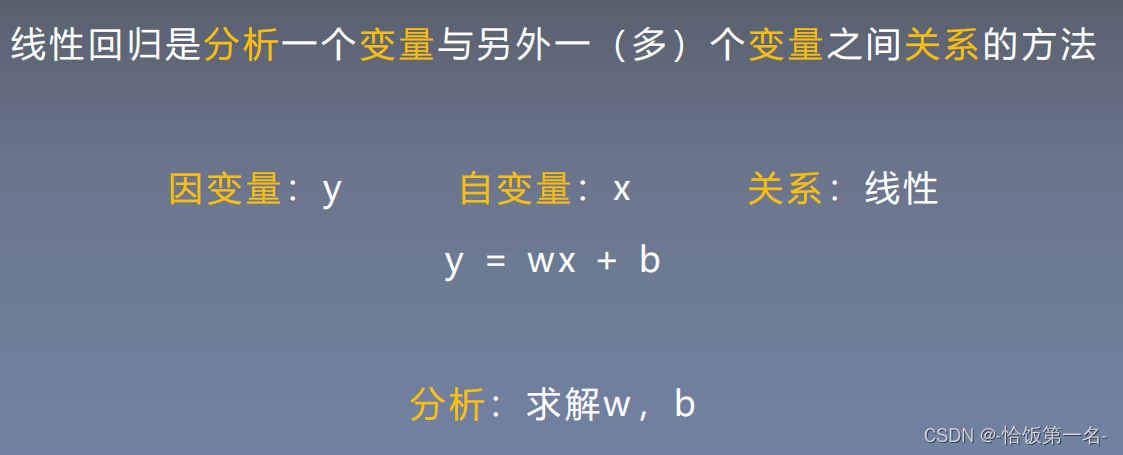
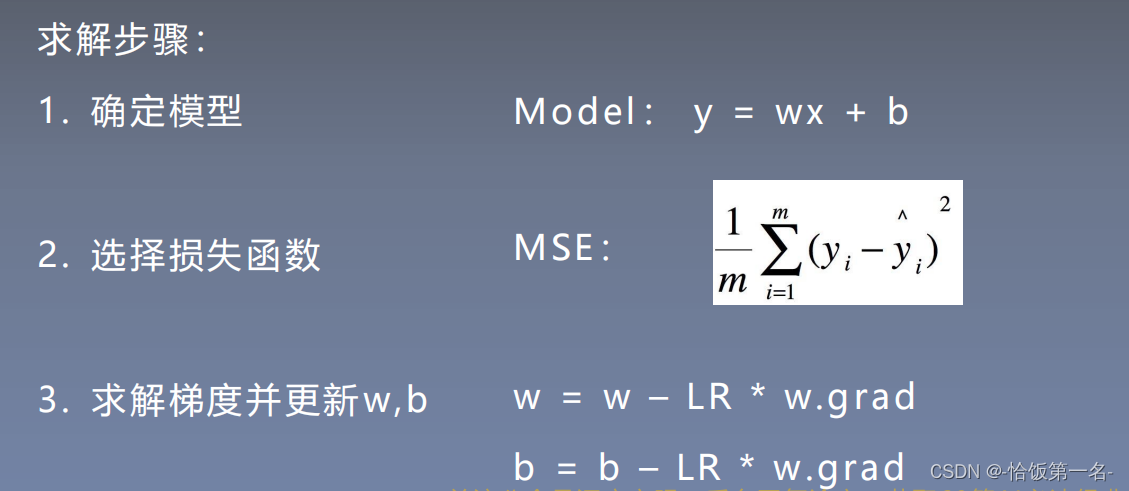
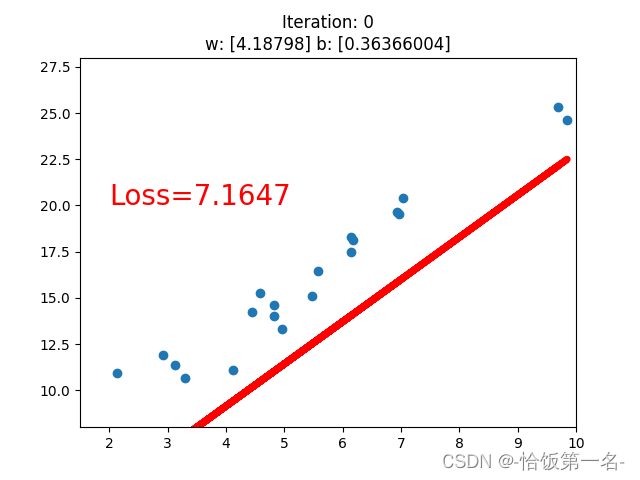
import torch
import matplotlib.pyplot as plt# 设置随机种子
torch.manual_seed(10)# 学习率
lr = 0.05# 创建训练数据
x = torch.rand(20, 1) * 10 # x data (tensor), shape=(20, 1)
y = 2*x + (5 + torch.randn(20, 1)) # y data (tensor), shape=(20, 1)# 构建线性回归参数
w = torch.randn((1), requires_grad=True) # 权重 w,随机初始化
b = torch.zeros((1), requires_grad=True) # 偏置 b,初始化为零# 迭代训练
for iteration in range(1000):# 前向传播wx = torch.mul(w, x) # wx = w * xy_pred = torch.add(wx, b) # y_pred = wx + b# 计算 MSE lossloss = (0.5 * (y - y_pred) ** 2).mean()# 反向传播loss.backward()# 更新参数b.data.sub_(lr * b.grad) # 更新偏置 bw.data.sub_(lr * w.grad) # 更新权重 w# 清零梯度w.grad.zero_()b.grad.zero_()# 绘图if iteration % 20 == 0:plt.cla() # 清除当前图形plt.scatter(x.data.numpy(), y.data.numpy()) # 绘制训练数据的散点图plt.plot(x.data.numpy(), y_pred.data.numpy(), 'r-', lw=5) # 绘制当前的拟合线plt.text(2, 20, 'Loss=%.4f' % loss.data.numpy(), fontdict={'size': 20, 'color': 'red'}) # 显示当前的损失值plt.xlim(1.5, 10)plt.ylim(8, 28)plt.title("Iteration: {}\nw: {} b: {}".format(iteration, w.data.numpy(), b.data.numpy())) # 显示当前的迭代次数和参数值plt.pause(0.5)if loss.data.numpy() < 1:breakplt.show() # 显示图形这段代码是一个简单的线性回归模型的训练过程,并且使用 matplotlib 库将训练过程可视化。
- 代码首先导入了 torch 和 matplotlib.pyplot 库,并设置了随机种子。
- 接下来,代码创建了训练数据,其中 x 是一个形状为 (20, 1) 的随机张量,y 是根据公式 2*x + (5 + 随机噪声) 生成的张量。
- 然后,代码定义了线性回归模型的参数 w 和 b,它们都是需要梯度计算的张量。
在每次迭代中,代码进行了以下操作:
- 前向传播:根据当前的 w 和 b 计算预测值 y_pred。
- 计算均方误差(MSE)损失函数。
- 反向传播:根据损失函数计算梯度。
- 更新参数:使用学习率 lr 和梯度更新参数 w 和 b。
- 清零梯度:使用 w.grad.zero_() 和 b.grad.zero_() 清零参数的梯度。
每隔 20 次迭代,代码会绘制训练数据的散点图,并在图中绘制当前的拟合线。同时,代码还会显示当前的损失值和参数 w、b 的数值。如果损失值小于 1,代码会提前结束训练。最后,通过 plt.show() 显示图形。

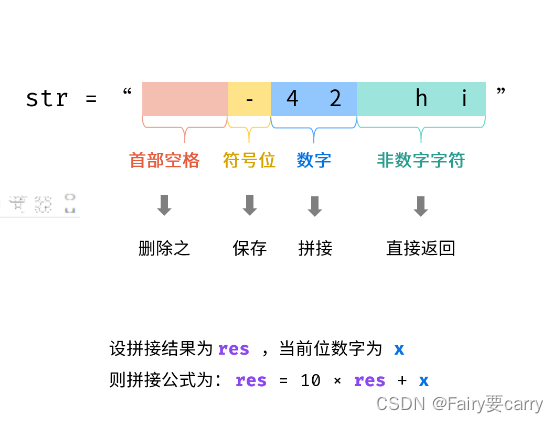
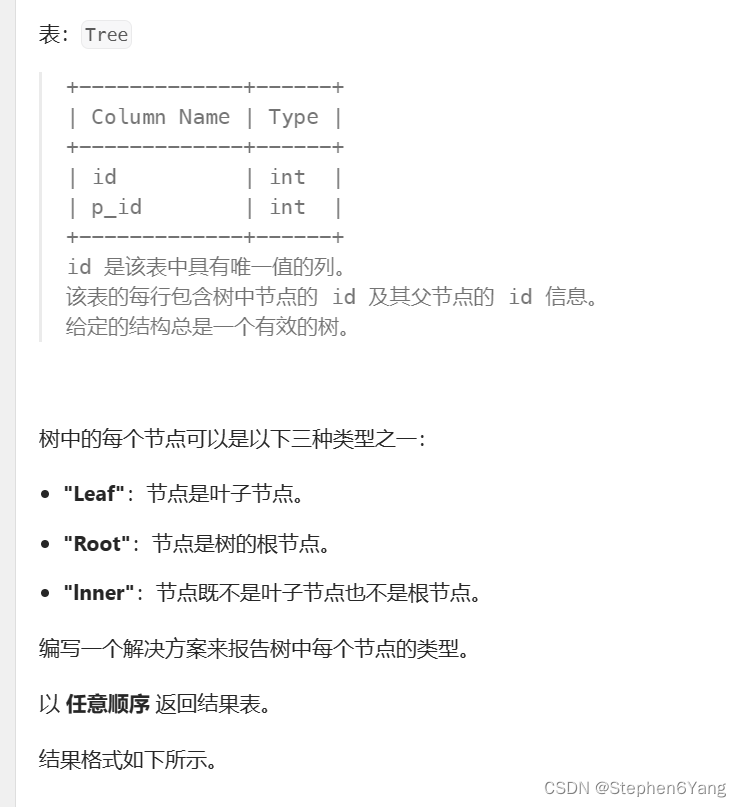


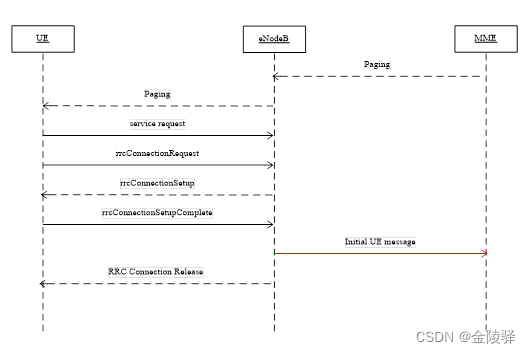


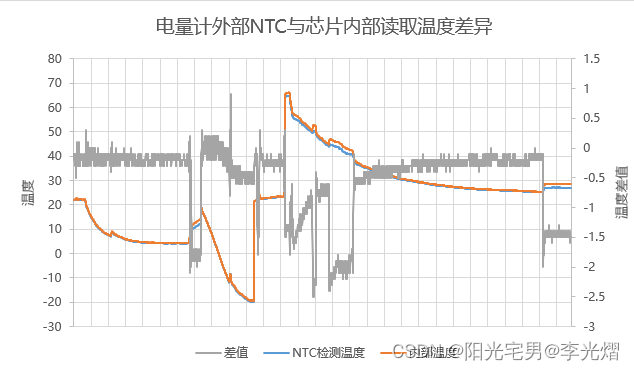



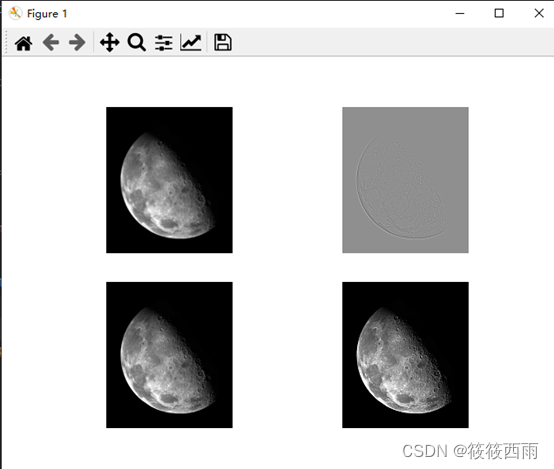

![Linux操作系统极速入门[常用指令]](https://img-blog.csdnimg.cn/direct/c7b1dfc1c1714edd9682e3f289855e82.png)
